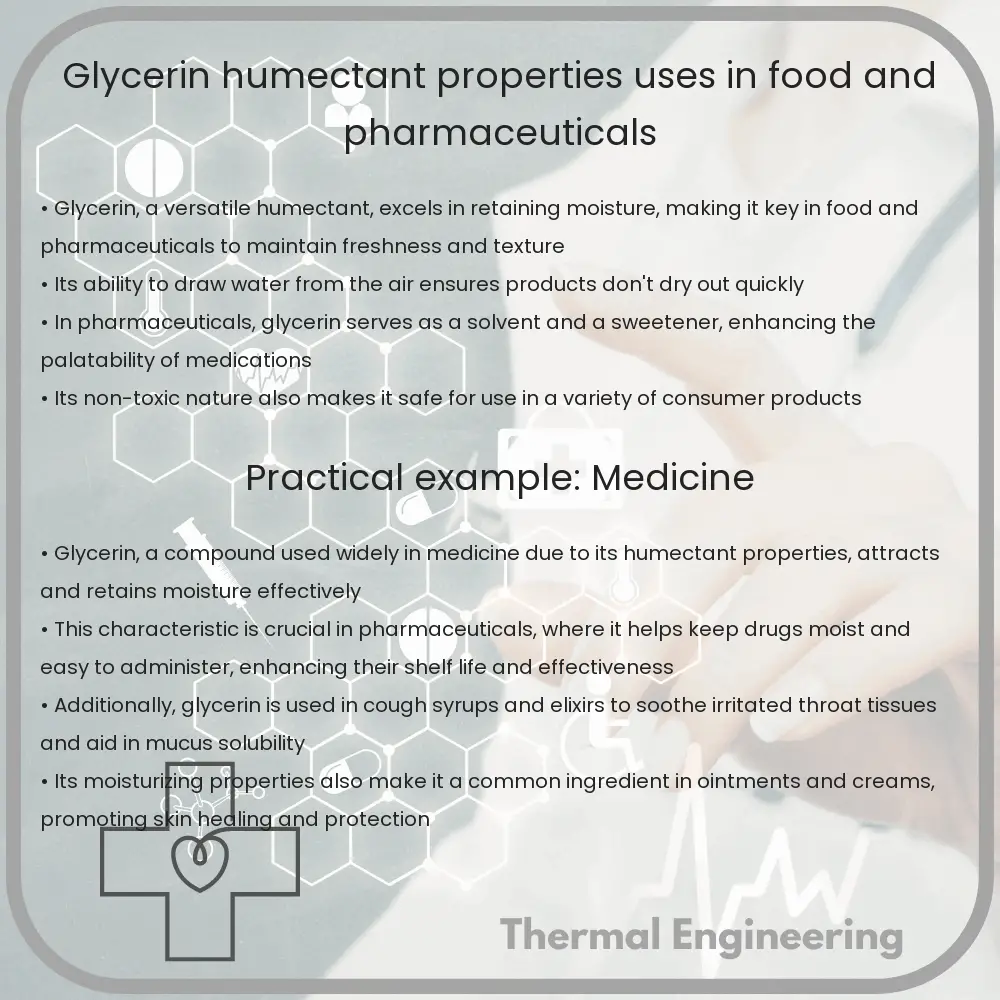Learn about glycerin’s role as a humectant in food and pharmaceuticals, its properties, and diverse applications.

Glycerin: Understanding Its Humectant Properties and Uses in Food and Pharmaceuticals
Glycerin, also known as glycerol, is a simple polyol compound with extensive applications across various industries due to its unique chemical and physical properties. It is a colorless, odorless, viscous liquid that is sweet-tasting and non-toxic. Central to its wide range of applications are its humectant properties, which are pivotal in food processing and pharmaceutical formulations.
What is a Humectant?
A humectant is a substance used to keep things moist. It works by attracting water from the surrounding environment through absorption, keeping the product with which it is mixed moist and increasing its shelf life. Glycerin is a highly effective humectant due to its hygroscopic nature, meaning it can attract and hold water molecules from its surroundings through either absorption or adsorption.
Glycerin’s Physical and Chemical Properties
The chemical formula for glycerin is C3H8O3, and it is structurally composed of three carbon atoms, eight hydrogen atoms, and three oxygen atoms. This structure allows glycerin to form strong hydrogen bonds with water molecules, enhancing its ability to retain moisture in products. Glycerin is soluble in both water and alcohol, which further expands its utility in diverse formulations.
Uses of Glycerin in Food Industry
- Moisture Retention: Glycerin is commonly added to baked goods, candies, and other processed foods to help retain moisture and thereby extend shelf life.
- Texture Enhancer: It serves as a softening agent in confectioneries like cakes and pastries, preventing them from drying out and maintaining a pleasing texture.
- Sweetening Agent: While glycerin is not as sweet as sugar, it is often used as a sweetener in low-fat food products and can also serve as a sugar substitute in dietetic foods.
- Solvent: It can act as a solvent for flavors and food coloring, making it easier to mix these additives into products without altering their stability.
Glycerin Uses in Pharmaceuticals
- Moisturizer: In topical, oral, and injected medications, glycerin is added to maintain adequate moisture content, ensuring the medicine remains effective during storage.
- Solvent: Glycerin serves as a solvent and carrier for active ingredients, aiding in the stability and effectiveness of the formulation.
- Ointments and Creams: It is extensively used in ointments and creams for its lubricating and softening properties, enhancing the spreadability and soothing effects on the skin.
- Laxatives: Glycerin is an active component in some laxatives, working as a hyperosmotic, drawing water into the intestines and stimulating bowel movements.
Glycerin in Everyday Products
Aside from food and pharmaceuticals, glycerin plays a crucial role in the production of multiple everyday products. It is a key ingredient in cosmetic products, personal care items like soaps and lotions, and even industrial applications such as anti-freeze formulations where its properties help to lower the freezing point of water. The biodegradable nature of glycerin also underscores its appeal in environmentally sensitive applications, reflecting its broader importance beyond just humectant properties.
Understanding the multifunctional uses of glycerin not only highlights its indispensable role in food and pharmaceutical industries but also encourages further research and potential uses in various other sectors. As a fundamental component in numerous products, glycerin continues to be an object of extensive study and application, harnessing its properties for innovative and effective solutions.